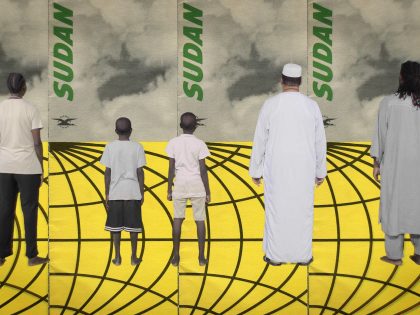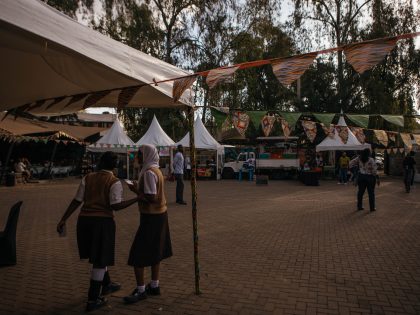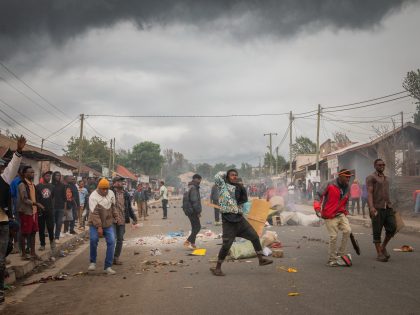The Goal is Clarity
When it comes to Israel and Palestine, for Americans, it doesn’t matter if the careful phrases contradict the most basic facts.

Imagem of the Qalandia Checkpoint between the northern West Bank and Jerusalem (The Author).
In the weeks since returning from the West Bank I’ve been tuned into the news, the news that stays news, and the news that isn’t news at all. The top story in the The New York Times on Wednesday, July 9th begins “Israel and Hamas escalated their military confrontation on Tuesday. . .” Inches away, the World Cup story allows: “The final score was Germany 7, Brazil 1. It felt like Germany 70, Brazil 1.” The juxtaposition of balance on one hand and the exaggeration of how unbalanced the World Cup rout felt on the other is too close to ignore. I dare say, with warfare again in the open in the region, it’s worth tracing its contours in our media, in our minds, and in our lives.
I know. It’s the oldest of old hats to note the distended shapes American journalism creates to preserve the Israel-first, false impression of some symmetry or parity between interests and powers in the contested territory split, shared, and struggled over by people known as Palestinians and Israelis. Even the names are disputed. Many Palestinians would refute the idea of “Israelis” and simply say Jews. Many Israelis have contended that, in fact, there are no “Palestinian” people. It’s territory—rhetorical, ethical, religious, ethnic, and geographic—so complexly, at times, hideously, contested that many people in the West, certainly in the U.S., simply look away. As a person who, since childhood, has lived a life athwart American racial codes and territories, I’ve always kept an eye on Israel / Palestine for the focused, if challenging, clarity it can offer one’s perspective on American experience. That might sound strange. But, it’s true. In a recent tour of the West Bank with the Palestinian Festival of Literature, in fact, I found much clarified.
This clarity is not complete, of course. It’s based on my own observations as well as conversations with people such as Ray Dolphin from the United Nations Office for the Coordination of Humanitarian Affairs in occupied Palestinian territories (UN OCHA), Dr. Tawfiq Nasser, Director of the Augusta Victoria Hospital in East Jerusalem and Omar Barghouti, founding member of the Palestinian Campaign for the Academic and Cultural Boycott of Israel (BDS). While touring the region, I was also reading, widely and variously and, at times, all night long (jet lag): James Baldwin’s letters (one from Israel) published in Harper’s in 1963; Etel Adnan’s incomparable two-volume, To look at the sea is to find what one is (2014); Sarah Schulman’s great memoir of (Jewish American) political re-awakening, Israel/Palestine and the Queer International (2012); the report, East Jerusalem: Key Humanitarian Concerns (2011), and the Humanitarian Atlas (2012) put out by the UN OCHA; and the Legal Unit Annual Report (2013) from the Czech-run Hebron Rehabilitation Committee. The Hebron Rehabilitation Committee recorded over 600 violations of Palestinian human rights during the calendar year, 2013. They’re very thorough. The report contains month-by-month charts in which each violation has its entry. Incidents are tabulated by category: against people; against property; by settlers; by Israeli soldiers. This daily array of violence presents, for one, a background I’ve yet to see appear in American media reporting the abduction and murder near Hebron (in Arabic, Al-Khalil) of three Jewish teenagers in June.
There’s active and latent anger and violence everywhere in the region. But, according to these sources, even in so-called “Palestinian” territory (occupied by and often under the control of Israeli military personnel), there’s absolutely no parity in the legal, military, and social contests between Israeli power and the Palestinian struggle. One is a contemporary bureaucratic state whose legal system vigorously operates to sustain and increase its hold on geographic territory and is possessed of a cornucopia of surveillance and weapon systems to back it up. The other is a disparate array of factionalized, anti-colonial resistance that uses smuggled and home-built weapons when not employing such high-tech systems as slingshots and cutlasses or simply throwing stones. Simply put there’s no contest here.
Looking around, say, at the closed-off, shut down, and vacant business district in Hebron, Shudada Street, or at the scorched guard tower and murals of martyred and imprisoned Palestinian leaders at the Qalandia checkpoint in East Jerusalem, Baby Shuggs comment from Toni Morrison’s Beloved rang in my ears, “Lay down your sword. This ain’t a battle; it’s a rout.” Staring at children at play in the Hebron streets under the shadow of iron bars and barbed wire and under the watch of Israeli guards with machine guns, or, just down the street from there, staring at armed soldiers, near-children themselves, deep in so-called Palestinian territory at yet another checkpoint, this one stenciled with a mural: “Free Israel,” I heard June Jordan’s visions, in “Requiem for the Champ,” of Brownsville, Brooklyn in the 1980s: “This is what it means to fight and really win or really lose. War means you hurt somebody, or something until there’s nothing soft or sensible left.”
Let’s stipulate that the Palestinian Authority does its best. But, the reality is that the PA is, at best, Superintendent to Israel’s occupation. The people know it; many resent it. At bottom, they work for the landlord. They’re in dialogue with Baby Shuggs. Hamas, meanwhile, newly beset, again, now by el-Sisi’s rule in Egypt, and contested within Gaza by even more militant factions, seems to be playing out the gambit June Jordan observed in the blasted out Brooklyn blocks of the 1980s. At the core of the Palestinian struggle, however, is the fundamental—not to say universal—urge that the Israeli/Jewish people—from their point of view, the oppressor—will not lead normal lives while Palestinians live in cages of restrictions made of law, concrete, and razor wire and very often watched over my men with machine guns. That Palestinian aim, in fact, isn’t foreign to an American sensibility, not at all; it’s incoherently twisted deep in the core of what America is supposed to afford people (“freedom”) while at the same time it’s there at the crux of what the United States has inflicted on subordinate, mostly non-white, populations of people, within and beyond its borders, since before it existed and until today.
This is the basis of the disturbing power of clarity the situation in Palestine / Israel confronts an American viewer with. When and if, that is, one is allowed a glimpse. This is why the American media operate in the way they do and it’s at the heart of why most Americans look away. In order to admit the most basic, blatant facts in the one situation—and exactly to the degree one finds a home in the American “mainstream” (itself an incoherently contested mythology), or “dream,”—people would need to give up or radically adjust primary illusions about the country in which they live: “individual achievement,” “equality of opportunity,” “an open society,” etc. In short, clarity about Palestine destroys the mainframe illusions of American whiteness, no matter the color of the person who aspires to it. No wonder Palestinians identify to the extent that they do, and they do, with the African American freedom struggle, and with the history of American Indian quarantine and displacement, in the U.S.
I am finding myself re-engaged with the psychological gymnastics of contemporary life wherein media images of LeBron James’ free agency and Neymar’s fractured vertebra butt up against gruesome political and social intensities—massacres in Coastal Kenya, 82 shootings and 14 dead in Chicago over the 4th of July, and, of course, renewed warfare in the West Bank and Gaza—as well as duties such as teaching my five year-old to ride a bike in the parking lot across the street. The struggle is to keep some semblance of perspective and proportion.
So it was on Wednesday morning that I found myself reading aloud to my wife, Stacey, from front-page stories in The New York Times as she got ready for work. One story frankly depicts Germany’s rout of Brazil, 7-1, from Tuesday, July 8th plain enough. Another, though, just inches apart on the page, frames conflict between forces in Gaza and Israel as a “military” contest of some plausible parity. “Israel and Hamas Trade Attacks as Tension Rises” reads the headline over a photo of a sizable explosion in an urban era. The silent suggestion in the headline being that the photo could be from either an Israeli or Hamas attack. Is that really possible? Is it plausible? Do Palestinians have a “military” at all? One report in the article ominously held that one Hamas-launched rocket made it almost seventy miles into Israeli territory. No mention was made of exactly what kind of navigation/aiming system those rockets use and what kind of explosives are attached. The previous evening, CNN’s Erin Burnett interviewed Israel’s Ambassador to the U.S. who described the near-total precision of Israeli strategic capabilities. His description served, at once, as an assurance about limited “collateral damage” and also as a bold declaration of unassailable Israeli power. The Ambassador’s interview stood alone as CNN’s report on the increasing violence that evening. The scorekeeping continued. In the war.
After the jump to page 8 in the Times, about the “military confrontation,” we’re told: “Israeli military said . . . that more than 150 rockets had been fired at Israel.” Meanwhile, the military reports that “Israel hit some 150 targets” in Gaza. So, at a glance, it’s a tie?
No scorecard was offered for how many targets, if any, in Israel were actually hit. One guess that, had there been hits, we’d know. Later in the story, confirming the Ambassador’s comments as to Israeli accuracy, or not, we’re told that targets hit in Gaza included, “five senior Hamas officials, ten smuggling tunnels, 90 concealed rocket launchers, and 18 weapons storage and manufacturing sites.” That’s 123. No mention of the other 27 hits in Gaza. No mention of how many firings were required to hit 123 targets. Elsewhere in the article, the tie score diverges, “Palestinian officials said that at least 23 people were killed in Gaza on Tuesday” while Israel reports “two people were wounded in rocket attacks on Monday” though it doesn’t say exactly how these injuries occurred or note their severity. If you’re willing to actually follow the news out of the region in American media, these are the kinds of feigned attempts at a balance that portray an evenly matched “military” struggle on one hand and, on the other, assure that one side has the unassailable upper hand and, of course, the unquestioned right to secure its territory.
So it is that equality, supremacy, and security all go together. Just don’t try it at home, these are trained professionals at work. Even so, exactly the same thing is happening at home, which is the whole point. Middle and upper class Americans are assured that everyone’s equal in the eyes of the system; meanwhile, they insist that their privileges and comforts (supremacy) are secure and that their right to safety is ensured.
When it comes to sports we’re free to feel the elasticity of the facts in pursuit of deeper truths, 7 to 1 felt like 70 to 1, we say, adding that “it wasn’t as close as the score suggests.” Such elasticity is delightful. No wonder why ESPN is what it’s become. Inches away, however, a story about an occupying power (one in violation of scores of international laws and accepted rules controlling political occupations) is told in ways that preempt and even invert a reader’s freedom to extend the facts into coherent feelings in order to understand the world. That elasticity is dangerous.
As I wrote this piece, on the morning of July 10th, NPR reports, now, 80 Palestinian are dead. Then, I woke up to reports of 100 dead and a report of one Israeli seriously injured at an exploded gas station. Now there’s been a fatality; an Israeli man delivering food to troops at the entrance to Gaza. Soon, there’ll be more. The numbers roll along, each a life, a death, each a blurring cloud of grieving and terrified people. In my morning brain, Baby Shuggs playing checkers with June Jordan, “king me, honey, will you please.”
Fully awake, it’s clear to me that when it comes to Israel and Palestine, for Americans, it doesn’t matter if the careful phrases contradict the most basic facts or if numerical equivalences depict “military” parity in one paragraph and describe unassailable supremacy in the next all the while affirming a people’s (one can’t but think, “all people’s?”) unquestionable right to security. No one’s looking that closely. They can’t. Close examination of Israel’s relationship to the Palestinians under their control, its quest for simultaneous supremacy, security, and the semblance of democracy or equality, would reveal more than Americans are willing to admit about our own towns, schools, states, and the filmy mythology that coats—whether with security or numbness no one investigates too far—our experiences of our own and each other’s lives.



















